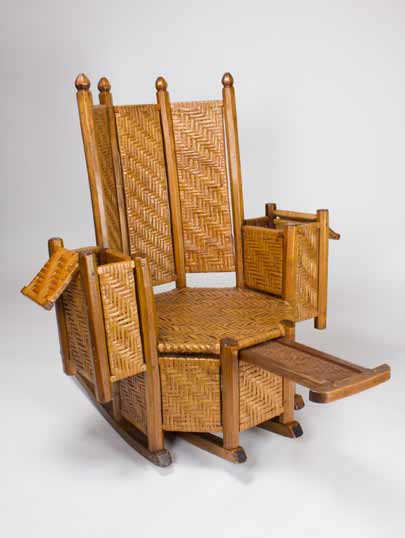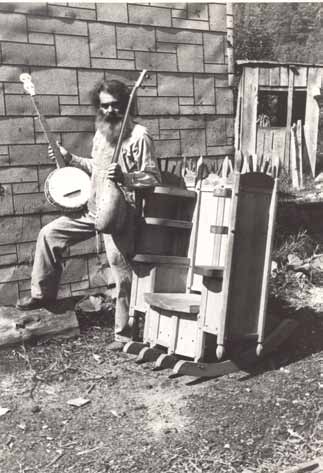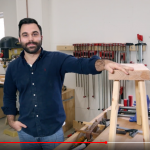We may receive a commission when you use our affiliate links. However, this does not impact our recommendations.
 One of my long-time obsessions has been with chairmaker Chester Cornett (1913-1981), a traditional Eastern Kentucky chairmaker who moved to Cincinnati later in life and turned to making mind-bending chairs.
One of my long-time obsessions has been with chairmaker Chester Cornett (1913-1981), a traditional Eastern Kentucky chairmaker who moved to Cincinnati later in life and turned to making mind-bending chairs.
Trained by his family in green chairmaking, Cornett made hundreds of chairs and other pieces of furniture during a time in the 20th century when the world was turning to manufactured goods. After serving in World War II, Cornett moved to the Cincinnati area and found clients who allowed his imagination go wild.
 Using traditional methods, Cornett began making rockers that had octagonal seats and eight legs. Chairs where every piece looked like a wiggling snake. An outrageous carved chair for President Richard Nixon. A woven basket-like rocker intended for President John Kennedy (who was assassinated before it could be delivered). And an unlikely rocker with bookshelves on the sides.
Using traditional methods, Cornett began making rockers that had octagonal seats and eight legs. Chairs where every piece looked like a wiggling snake. An outrageous carved chair for President Richard Nixon. A woven basket-like rocker intended for President John Kennedy (who was assassinated before it could be delivered). And an unlikely rocker with bookshelves on the sides.
For many years, the only source of information I had on Cornett was the excellent book “Craftsman of the Cumberlands” by Michael Owen Jones. The only demerit to the book: the muddy photos printed on uncoated paper.
Now there’s a recent book you can download (for free) “Chester Cornett: Beyond the Narrow Sky” (Morehead State University) that is filled with gorgeous color photos of Cornett’s work, spanning his early chairs and reaching into his more artistic works. It’s a short book and definitely worth a read.
And if you want to read even more, check out this great article on Cornett from Cincinnati Magazine.
I hope to get out to Morehead’s Kentucky Folk Art Center to examine some of Cornett’s chairs in person. And down to Lexington, Ky., where the University of Kentucky has some of his pieces in its collection.
This will be a strange return to where I began – my first woodworking classes were at the University of Kentucky in 1993 – investigating where I might go next.
— Christopher Schwarz
Here are some supplies and tools we find essential in our everyday work around the shop. We may receive a commission from sales referred by our links; however, we have carefully selected these products for their usefulness and quality.










RE. Story and An Unrelated Roubo Bench Question:
Great read (and how ’bout that crafty address on his house?) Too bad there wasn’t any info on his methods and tools.
On another note (and not knowing where to post or ask), I’ve got a question about wood for a roubo bench that will use hold holdfasts:
Was considering ambrosia maple (maybe 4-5″ in thickness). A guy wondered if the wormholes and fungus in the ambrosia maple affected its density in places to the degree that it would compromise the bite of a hold fast (and I was planning on getting those bigguns from Lost Art Press). Splitting hairs? Any foreseeable problems using the less expensive ambrosia? This question got me thinking about something I haven’t come across: While edge grain slickness or tackiness has been discussed, does the end grain of certain bench woods affect its ability to grab or sustain integrity for hold fast holes? I could go Doug. Fir and be happy with that (there’s also a good local price for cherry), but the question remains: Given a 4 to 5 inch top thickness, what say ye savvy goode fellews on end-grain integrity and grabiness/tack for hold fasts over the long term? Thanks!
And forgot, just FYI
He made it to Antiques Roadshow too
http://www.pbs.org/wgbh/roadshow/season/4/columbus-oh/appraisals/chester-cornett-rocker–199907A17/
https://www.appalshop.org/store/appalshop-films/hand-carved/
https://vimeo.com/38520882
https://www.appalshoparchive.org/2015/07/01/welcome-home-to-our-chester-cornett-chair/
So he pegged his chair rails on the edges instead of through the tenons?
They look like he made them with an axe.
Interesting article about a troubled man. I need more help understanding just why he was called the king of chair makers as I didn’t see anything particularly appealing about any of his chairs. In particular, his “artsy” chairs were, in my opinion, just hideous and I certainly wouldn’t call them art. I guess that is why art is in the eye of the beholder.
Two great reads. I remember seeing the snake chair on ARS and being completely mesmerized. Haven’t thought much about him or his chairs since. Thanks for the reminder.
In Michael Jones’ book he describes Cornetts workholding bench on page 15 and shows a photo of it on page 25. Sure looks a lot like the Roman benches you’ve been describing.